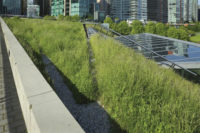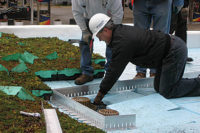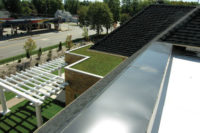Green, Greener, Greenest?
Sustainable Roofing






I attended the Energy Efficient Roofing Conference in Charlotte, N.C., this past April. The event was hosted by Principia, a consulting firm focused on the building materials industry and based in Malvern, Pa. There were many excellent speakers, topics and presentations over the two-day conference. However, one presentation that really hit my sensibilities was given by Mike Fischer, the director of codes and regulatory affairs for Kellen Technical Services.
Mr. Fischer’s presentation, titled “Onondaga County (N.Y.) Penitentiary Re-roof Project: Lessons Learned and Implications for Roof Design,” discussed research on four penitentiary buildings in upstate New York, near Syracuse. The research report, titled, “Comparative Roof Testing at Onondaga County Correctional Facility” was completed in October 2011, and performed by Ashley-McGraw Architects, Syracuse, N.Y., and CDH Energy Corp., Cazenovia, N.Y.
Opportunities such as this don’t come along too often. Four existing buildings, identical in size and design, and all having the same occupant schedules, were re-roofed at the same time. One roof included a black EPDM membrane with 4 inches of foam insulation; one roof included a vegetative roof with 4 inches of foam insulation; one roof included a white TPO roof with 4 inches of insulation; and one roof included a white TPO roof with 8 inches of insulation. Extensive instrumentation was installed during the re-roofing process in order to capture performance criteria (e.g., temperature at locations under, within, and at the surface of the roof system).
Perhaps as expected, the white membranes and the vegetative roof had lower roof surface temperatures, and because of the reduced surface temperature, there is a reduction of solar heat gain in the cooling months (summer) and an increase in heat loss during heating months (winter). From the executive summary: “Compared to the EPDM membrane, the TPO roof had 30 percent higher heating losses and the vegetative roof had 23 percent higher losses. The TPO roof with extra insulation did have lower heating losses than the EDPM roof.”
This means there can be a heating penalty for white roofs in heating climates, but it all depends on the amount of insulation. What is critically important to recognize is the white roof with 8 inches of insulation has less heating loss than the black roof with 4 inches of insulation. This shows that insulation — at the proper amounts — trumps roof color in heating climates relative to the energy efficiency of the building. This means the building owner will spend less on heating and cooling when there is a high R-value thermal layer, regardless of the roof color.
Keeping this in perspective, at the time of this project, building-code requirements for insulation were less than they are today. If this project was done today and the roof design followed the IECC 2012 Climate Zone 5 requirement for insulation, the roofs would require an R-value of 25. If I were designing the insulation layer, I’d specify 5 inches of polyiso. This is based on using a system approach to R-value design, versus using R-values for individual boards. Therefore, the roof will have a high R-value, and as shown in the study, roof color is less important, again relative to the energy efficiency of the building. (Please note, using the system approach, the 8-inch insulation layer in the study has an R-value of 40, still well above the minimum code requirement of 25.)
Given the complexity of roof design relative to a building’s energy efficiency and considerations for the environment, a high R-value thermal layer should be the focus for a building’s energy efficiency, and the roof surface should be the focus when it comes to surface temperature. Of course, both have implications relative to the environment. There are arguments for high R-value, arguments for lighter colored roof surfaces, and there are still more arguments for installation of vegetated roof surfaces. Many benefits of vegetated roof systems are discussed in the report as well. Cost will forever be an issue, as will maintenance. There isn’t one answer; however, this study provides a convincing case that insulation is critically important, and the R-values in the building code should be followed as absolute minimums for roof design.
While this study was done on buildings in Climate Zone 5, this is great empirical data. The study is worth reading. You’ll be better informed to discuss roof color, insulation, vegetative roofs, and most importantly, how all of these interact. Roofs are complex; there is plenty of building science involved, and these issues should be thought about and discussed together, not separately.
Looking for a reprint of this article?
From high-res PDFs to custom plaques, order your copy today!









